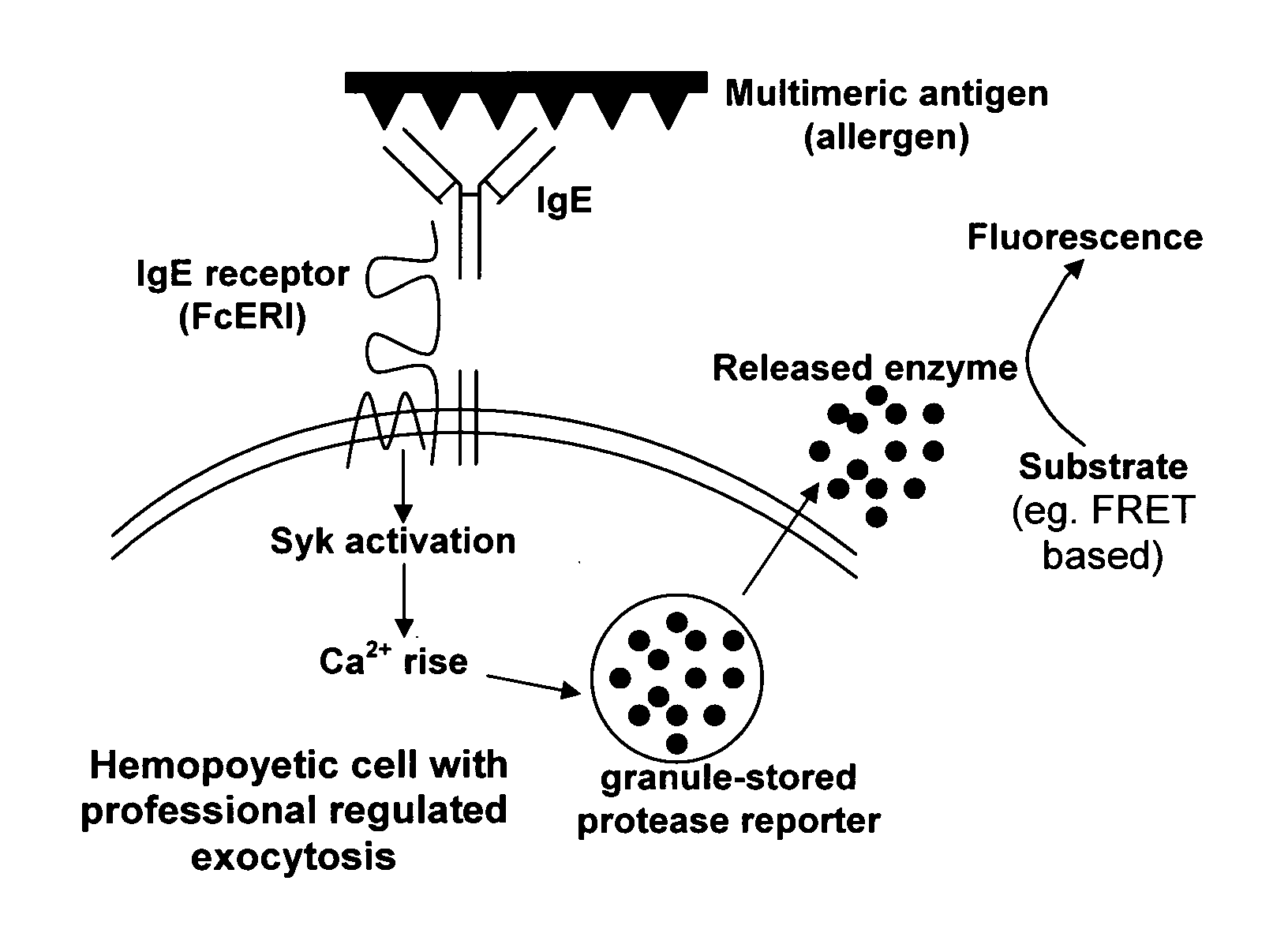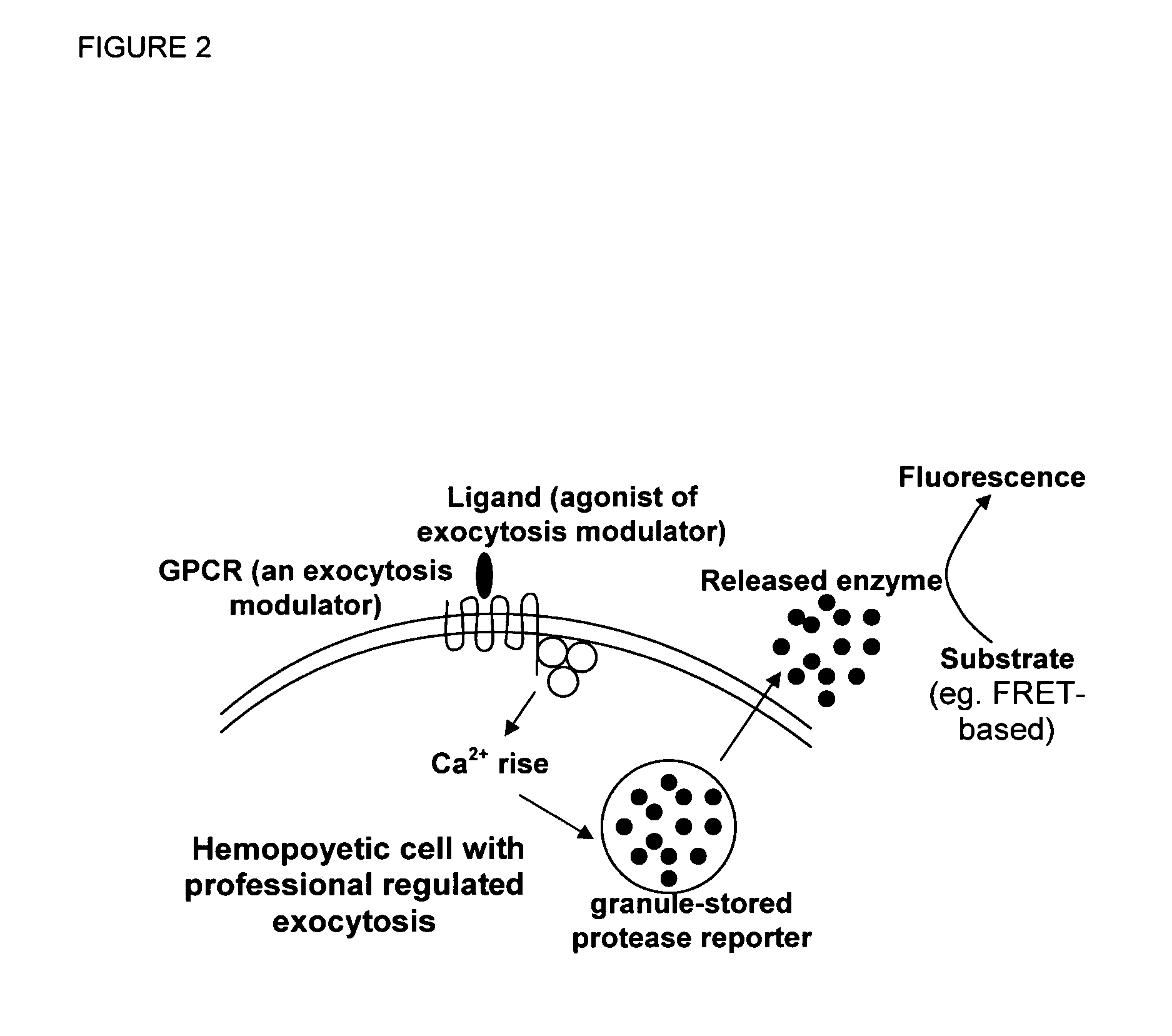Novel ultrasensitive cell based sensors and uses thereof
a cell-based sensor, ultra-sensitive technology, applied in the field of new cell-based sensors, can solve the problems of not being able to detect small molecule modulators, not being able to deorphan orphan receptors, radioligand assays failing to detect responses, etc., and achieve the effect of enhancing the magnitude of initial signals
- Summary
- Abstract
- Description
- Claims
- Application Information
AI Technical Summary
Benefits of technology
Problems solved by technology
Method used
Image
Examples
example 1
Selection of Useful Cell Lines for the Methods of the Present Invention
[0170]Several cell lines were transiently transfected with Lipofectamine 2000 (Invitrogen, USA), Superfect (Qiagen, Germany) or transiently electroporated with a microporator (Digital Bio Technology, South Korea) with pCMVSport-hGranzyme B vector, a vector in which human granzyme B is under the control of human CMV promoter (SEQ ID NO:8). This vector was used for selection of cells with professional granule exocytosis of granule reporters like granzymes. After 48 hours the cell culture media was changed and the basal level after 1 hour of culture without stimulus was evaluated by comparison with cells treated for 1 hour with ionomycin at 10 uM as inductor of granule exocytosis. The amount of granzyme B secreted into the culture media was evaluated by both a sandwich ELISA specific for human granzyme B (Ucytech, Netherlands) to quantify the total amount of protein using supernatant equivalent from 100.000, 50.000,...
example 2
Selection of Useful Promoters for Reporter Expression in the Methods Of the Present Invention Using Transient Transfection
[0171]Vectors were developed for expression of human granzyme B under the control of the following promoters: Moloney Leukaemia virus 5′-LTR (MoLV5′LTR, SEQ ID NO:3), human cytomegalovirus promoter, human phosphoglycerate kinase promoter and a chimeric promoter of human cytomegalovirus promoter and Moloney Leukaemia virus 5′-LTR (hCMV-MoLV5′LTR, SEQ ID NO:10). Each vector was individually transiently transfected by electroporation using a microporator (Digital Bio Technology, South Korea) into RBL-2H3 under standard conditions and 48 hour later cell were counted and seeded the night before experiment at a density of 100.000 cells per well in a 96 well microplate. Next day cells were washed with BSS buffer and treated for 1 hour treatment with ionomycin at 10 uM in a total volume of 30 microliters. Supernatants were assayed for granzyme B by a sandwich ELISA (Ucyt...
example 3
Development of Stable Cell Lines Expressing Human Granzyme B Under the Control of hCMV-MoLV5′LTR Chimeric Promoter, MoLV-5′LTR Promoter and hCMV Promoter
[0173]Vectors were developed for stable expression of human granzyme B under the control of hCMV-MoLV5′LTR chimeric promoter, MoLV-5′LTR promoter or hCMV promoter. A hygromycin resistance cassette was included in the vector backbone for selection of stable populations of cells. The vector also included an IRES-NGFR (SEQ ID NO: 12) cassette cloned downstream of human granzyme B and thus, under the control of the same promoter for flow cytometry and / or selection of stable cells expressing granzyme B. Each vector was individually electroporated using a microporator (Digital Bio Technology, South Korea) into RBL-2H3 and after 48 hours hygromycin at 1500 ug / mL was added to culture for selection. After selection for about 2 weeks cells were analysed by flow cytometry (Guava Technologies, USA) with an antibody against NGFR coupled to FITC....
PUM
| Property | Measurement | Unit |
|---|---|---|
| Nanoscale particle size | aaaaa | aaaaa |
| Nanoscale particle size | aaaaa | aaaaa |
| Nanoscale particle size | aaaaa | aaaaa |
Abstract
Description
Claims
Application Information
 Login to View More
Login to View More - R&D
- Intellectual Property
- Life Sciences
- Materials
- Tech Scout
- Unparalleled Data Quality
- Higher Quality Content
- 60% Fewer Hallucinations
Browse by: Latest US Patents, China's latest patents, Technical Efficacy Thesaurus, Application Domain, Technology Topic, Popular Technical Reports.
© 2025 PatSnap. All rights reserved.Legal|Privacy policy|Modern Slavery Act Transparency Statement|Sitemap|About US| Contact US: help@patsnap.com



